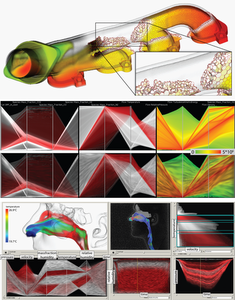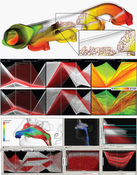Information
- Publication Type: PhD-Thesis
- Workgroup(s)/Project(s):
- Date: 2012
- Date (Start): 2007
- Date (End): 2012
- TU Wien Library:
- 1st Reviewer: Eduard Gröller
- 2nd Reviewer: Markus Hadwiger
- Rigorosum: 15. June 2012
- First Supervisor: Eduard Gröller
Abstract
Data from numerical simulations that model physical processes has to be explored and analyzed in a broad range of different fields of research and development. Besides data mining and statistics, visualization is among the most important methods that grant domain experts insight into their complex simulation results. In order to keep up with ongoing improvements of simulation methods as well as ever increasing amounts of data, state-of-the-art visualization techniques have to be scalable with respect to many different properties. Many numerical models rely on a domain decomposition defined by a volumetric grid. Finer grids yield more accurate simulation results at the cost of longer computing times. The wide availability of high-performance computing resources has resulted in increasingly detailed data sets. The first volume rendering approach that is presented in this thesis uses bricking and resampling to cope with such high resolution data. Important regions of the simulated volume are visualized in as much detail as possible whereas lower resolution representations are used for less important portions of a data set. This allows for interactive frame rates even when dealing with the highly detailed grids that are used by state-of-the-art simulation models. Grid resolution, however, is only one aspect that has increased due to the ongoing development of numerical methods. Grid complexity has increased as well. While initial simulation techniques have required simple tetrahedral meshes current methods can cope with polyhedral cells that allow for increased solver efficiency and simulation accuracy. The second volume visualization algorithm that is presented in this thesis is scalable with respect to grid complexity since it is capable of directly visualizing data defined on grids which comprise polyhedral cells. Raycasting is performed by using a novel data structure that allows for easy grid traversal while retaining a very compact memory footprint. Both aforementioned volume rendering techniques utilize the massively parallel computing resources that are provided by modern graphics processing units. Many information visualization methods are designed to explore and analyze abstract data that is often high dimensional. Since improvements in the field of numerical modelling have led to simulation data sets that contain a large number of physical attributes the application of techniques from the field of information visualization can provide additional important information to domain experts. However, in order to apply information visualization methods to scientific data such as numerical simulation results, additional scalability issues have to be addressed. This thesis introduces multiple methods that can be used to reduce cluttering and overdrawing problems for line-based techniques such as phase-space diagrams, parallel coordinates and a novel time-series visualization. The trajectories of important trends in the data are illustrated by blurring a noise texture along them. A novel coloring scheme is used to provide visual linking-information across multiple visualizations in a multi-view framework. The proposed approaches are primarily image-based which makes them very scalable with respect to data set sizes. The usefulness and real-world applicability of the techniques that are introduced in this thesis is demonstrated in a case study. A complex computational fluid dynamics data set, which contains several simulated breathing cycles within the human upper respiratory tract, is analyzed. The exploration of the data has yielded several hypothesis that are of importance to an ENT specialist. Many of the techniques presented in this work have also been used in the context of additional collaborations in a multitude of fields such as medicine, climatology, meteorology, and engineering.Additional Files and Images
Weblinks
No further information available.BibTeX
@phdthesis{muigg-2012-svr,
title = "Scalability for Volume Rendering and Information
Visualization Approaches in the Context of Scientific Data",
author = "Philipp Muigg",
year = "2012",
abstract = "Data from numerical simulations that model physical
processes has to be explored and analyzed in a broad range
of different fields of research and development. Besides
data mining and statistics, visualization is among the most
important methods that grant domain experts insight into
their complex simulation results. In order to keep up with
ongoing improvements of simulation methods as well as ever
increasing amounts of data, state-of-the-art visualization
techniques have to be scalable with respect to many
different properties. Many numerical models rely on a domain
decomposition defined by a volumetric grid. Finer grids
yield more accurate simulation results at the cost of longer
computing times. The wide availability of high-performance
computing resources has resulted in increasingly detailed
data sets. The first volume rendering approach that is
presented in this thesis uses bricking and resampling to
cope with such high resolution data. Important regions of
the simulated volume are visualized in as much detail as
possible whereas lower resolution representations are used
for less important portions of a data set. This allows for
interactive frame rates even when dealing with the highly
detailed grids that are used by state-of-the-art simulation
models. Grid resolution, however, is only one aspect that
has increased due to the ongoing development of numerical
methods. Grid complexity has increased as well. While
initial simulation techniques have required simple
tetrahedral meshes current methods can cope with polyhedral
cells that allow for increased solver efficiency and
simulation accuracy. The second volume visualization
algorithm that is presented in this thesis is scalable with
respect to grid complexity since it is capable of directly
visualizing data defined on grids which comprise polyhedral
cells. Raycasting is performed by using a novel data
structure that allows for easy grid traversal while
retaining a very compact memory footprint. Both
aforementioned volume rendering techniques utilize the
massively parallel computing resources that are provided by
modern graphics processing units. Many information
visualization methods are designed to explore and analyze
abstract data that is often high dimensional. Since
improvements in the field of numerical modelling have led to
simulation data sets that contain a large number of physical
attributes the application of techniques from the field of
information visualization can provide additional important
information to domain experts. However, in order to apply
information visualization methods to scientific data such as
numerical simulation results, additional scalability issues
have to be addressed. This thesis introduces multiple
methods that can be used to reduce cluttering and
overdrawing problems for line-based techniques such as
phase-space diagrams, parallel coordinates and a novel
time-series visualization. The trajectories of important
trends in the data are illustrated by blurring a noise
texture along them. A novel coloring scheme is used to
provide visual linking-information across multiple
visualizations in a multi-view framework. The proposed
approaches are primarily image-based which makes them very
scalable with respect to data set sizes. The usefulness and
real-world applicability of the techniques that are
introduced in this thesis is demonstrated in a case study. A
complex computational fluid dynamics data set, which
contains several simulated breathing cycles within the human
upper respiratory tract, is analyzed. The exploration of the
data has yielded several hypothesis that are of importance
to an ENT specialist. Many of the techniques presented in
this work have also been used in the context of additional
collaborations in a multitude of fields such as medicine,
climatology, meteorology, and engineering.",
address = "Favoritenstrasse 9-11/E193-02, A-1040 Vienna, Austria",
school = "Institute of Computer Graphics and Algorithms, Vienna
University of Technology ",
URL = "https://www.cg.tuwien.ac.at/research/publications/2012/muigg-2012-svr/",
}


 Thesis
Thesis
